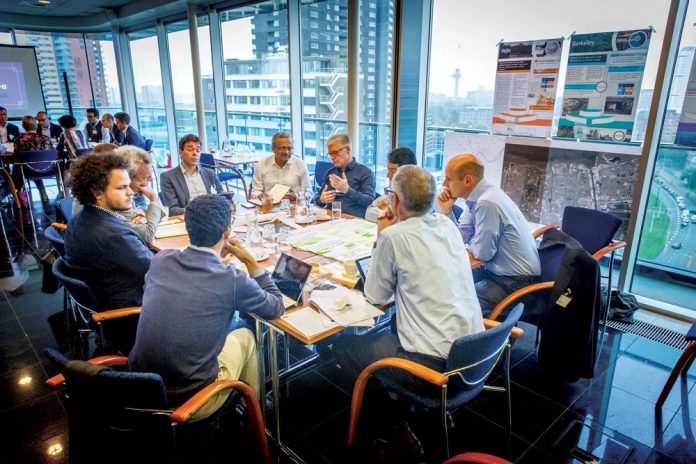
Since the first was appointed in San Francisco in April 2014, 100 Resilient Cities–Pioneered by The Rockefeller Foundation has helped to fund the hiring of over 50 Chief Resilience Officers (CROs) around the world. While few CROs are specifically trained in water issues, Nick Michell looks at whether they can have a significant impact on creating a sustainable urban water agenda
In May 2013, The Rockefeller Foundation launched the 100 Resilient Cities Network (100RC) as part of its centennial commitment to urban resilience. They backed their pledge to help cities around the world become more resilient to natural disasters and climate change through direct grants to each selected city.
Despite the significant amount of useful research and toolkits already being produced on urban resilience, Rockefeller wanted to create a new position in the city government to coordinate the resilience strategy and was prepared to fund the appointment of a Chief Resilience Officer.
There are now over 50 Chief Resilience Officers working in cities across the world but few are specifically trained on water issues. They tend to be urban managers with a good understanding of governance and social issues, and stronger skills in urban planning and mobility. Some however are very strong on matters relating to water and can become an asset to others by sharing their experience, and helping to enact change.
“The CROs can play a key role in bridging between different departments of the city with the aim to improve resilience,” says Corinne Trommsdorff, Programmes Manager for Cities of the Future at the International Water Association. “Because water plays a significant role in so many facets of the city such as health, economic stability, wellbeing and mobility, it can become a great entry point to increase the awareness of all city stakeholders and different planning departments to the need for integrated planning of the city and the need for collaboration across urban disciplines. Increasing the CROs’ knowledge on water issues would benefit all aspects of their work towards increasing city resilience.”
Knowledge exchange
In October 2015, Chief Resilience Officers and resilience team members from Bangkok (Thailand), Berkeley (USA), Mexico City, New Orleans (USA), Norfolk (USA), Rome (Italy), Rotterdam (the Netherlands), Surat (India), and Vejle (Denmark), convened in Rotterdam for a Network Exchange on integrated water management, as part of the 100 Resilient Cities Network Exchange Program.

As a delta city situated primarily below sea level, Rotterdam has designed solutions that not only aim to reduce flooding in the city, but also connect water to economic opportunity, recreation, and beautification. This focus on building multi-benefit solutions is a key tenet of resilience.
“The exchange allowed me the space to explore innovative measures for designing a city that can successfully manage increased amounts of water, while at the same time producing spaces that act as community amenities when not being used for water management,” says Christine Morris, Chief Resilience Officer of Norfolk. “The exchange gave me a chance to see in action how former hardscapes such as roofs, pavements and sidewalks are being reconfigured to provide green space that not only slows stormwater, but are growing produce, providing art and functioning as community gathering spaces.”
The exchange allowed CROs to discuss and explore key, replicable innovations, from floating structures designed to respond dynamically to rising sea levels to ‘sponge zones’ for absorbing excess stormwater.
The participants shared tactical approaches and tools to put together the eight key lessons learned around project ideation, design, and implementation. Each lesson is supported by a number of practical measures discussed at the Exchange, case studies showing how these approaches have been employed in other cities, and 100RC Platform tools that can be used for implementing them.
The CROs looked at the market needs for resiliencebuilding tools by addressing private sector providers and signalling what kind of tools and services need to be created or scaled to sustain a resilient water agenda.

“At the start of the exchange, it might have seemed that our challenges and project proposals were very disparate, ranging from community engagement tactics to major gray infrastructure projects,” explains Jeff Hebert, Chief Resilience Officer of New Orleans.
“However, by the end of the exchange, it was clear that each CRO was deriving value from every case study and workshop session—ultimately questioning many of the assumptions that we had walking into the discussions.”
The Rotterdam Exchange catalysed real and concrete action and attendees returned to their cities to act upon the lessons learned and relationships built with fellow CROs, Dutch experts, and 100RC Platform Partners.
Early examples include: Norfolk, New Orleans, and Rotterdam now collaborating to enhance port resilience, while Norfolk is also evaluating piloting floating structures to help design the coastal community of the future.
Mexico City and Rotterdam are exchanging technical information about how to implement water plazas in the Mexican capital and Vejle is reconceptualising a sluice project with a water-resilient lens.

“In Mexico City, we are already replicating some of the ideas that we experienced in Rotterdam,” says Arnoldo Matus Kramer, Chief Resilience Officer of Mexico City. “One of the members of Mexico City’s Delegation is a member of the Public Space Authority of the Government of Mexico City who is leading now the construction of La Viga Park, a public park that will retain and reuse water. Moreover, we are working on guidelines for green and blue infrastructure for the city in collaboration with Urbanisten and Deltares, two Dutch organisations that we met at the Rotterdam Exchange.”
A water vision
The recently approved Sustainable Development Goals are a bold call for the promotion of sustainable urban water management for safer, more inclusive and resilient cities. To achieve this there is a need to harness the power of collaboration: a new paradigm for water management infrastructures and policies, enabled by new governance that spurs broader collaboration, motivates stakeholder engagement and active citizenship involvement.

The Chief Resilience Officer can play a critical role in inspiring other urban leaders to a shared progressive water vision and instigate governance that enables collaboration.
The International Water Association has drafted The Principles for Water Wise Cities, to be launched at the IWA World Water Congress in Brisbane, with the aim of providing the necessary frameworks to assist urban leaders to develop and implement their vision for sustainable urban water, and to help with resilience planning.
The ultimate goal of these Principles is to encourage collaborative action, underpinned by a shared vision, so that local governments, urban professionals, and individuals actively engage in addressing and finding solutions on urban water management challenges. (See box).
The Principles for Water Wise Cities propose five building blocks for implementation of sustainable urban water programmes, and for each of the blocks, the CRO can play a critical role:
• Vision: the CRO is key in developing a tailored progressive water vision, specific to its city, that will be the first building block towards a water wise city
• Governance: the CRO, through its cross-sectoral mission is key in instigating the collaboration across departments of city planning
• Knowledge and capacities: the CRO, through his access to the 100 Resilient City Knowledge Platform and network of cities may propose adequate support to build the capacities to work together across sectors, and be inspired on solutions for sustainable urban water
• Planning tools: the CRO can support city planning departments in identifying the planning tools that enable decision making
• Implementation tools: the CRO, inspired through their network, may propose innovative contracting, financing or policies that support sustainable urban water projects to become reality.
“I view the CRO as a key person to initiate a progressive water vision for a city, working hand in hand with the city leaders, the professionals including the utilities, and the institutions,” says Corinne Trommsdorff at the IWA. “The CRO is also key to instigating a bottomup vision for sustainable urban water, leading to engaged citizens. Change cannot be the result of one person working, but it can be the result of one person inspiring many to do what they do differently to achieve an ambitious goal.”
Ability to make change
Water is impacting the city in many more ways than just as a basic service. Water may bring social inclusion, create attractive public spaces and lead to a reduction in heat islands, but it is also a risk to the city that can be mitigated by planning for safe flooding spaces as multi-purpose areas providing recreation and social inclusion.
These are the issues that a Chief Resilience Officer must highlight and emphasise within their city administration, but are often hindered by the low perception of the risks of poor urban water management in the political agenda and civil society. As a new role, attempting to work across government departments to help a city improve internal communications, it is vital that CROs build relationships and formulate innovative resilience strategies, if a coherent and shared water vision is to be achieved.
“The CRO is a new position for all cities,” says Dr Tantikom Supachai, Chief Resilience Officer of Bangkok. “It doesn’t matter where you are, creating a new permanent position within a city organisation that will traverse many different departments will take time. As CRO, I work under the Governor to develop resilience strategies with the help from government officers from several different departments. A CRO can help facilitate the coordination across departments but the responsibility to make change is ultimately still theirs.”
By facilitating communication that reaches across sometimes significant internal divisions, the CRO makes sure that offices aren’t wasting resources doing duplicative work; and promotes synergy between the various projects and the plans that agencies are drafting.
“From my experience I believe the CRO needs a powerful voice, and not more power as an authority,” says Jonas Kroustrup, Chief Resilience Office of Vejle. “It’s not by force or governance that you mobilise partnerships. It’s by creating a common goal that is leading towards a shared outcome.”
Benefits
Probably one of the most valuable aspects of the Chief Resilience Officer’s position is the peer network that comes with it. Being able to work with counterparts from around the world allows the city access to best practices, lessons from past failures, and the humility to recognise that its issues at home are not necessarily unique.

The CROs are learning from each other every day and the network has provided the opportunity to look beyond their own borders for the latest and best, but also those proven approaches and solutions that have been effectively employed.
While not having direct authority to make or change legislation, CROs can make a significant difference by bridging gaps between departments, working with city leaders, and helping create a progressive water vision for the city. That doesn’t just mean water management projects, it means communicating risk, updating land use policy, helping to establish resident-to-resident networks that protect vulnerable populations, thinking about how to implement solutions in ways that bring multiple benefits to citizens, and helping people thrive economically and socially in this changing environment.
“This is a team game,” states Norfolk’s Christine Morris. “For a city like ours, the role of the CRO is more to coordinate the residents’ and businesses’ efforts to adapt. My job is not to replace the current system but to augment it in ways that result in more benefits to our citizens.”







